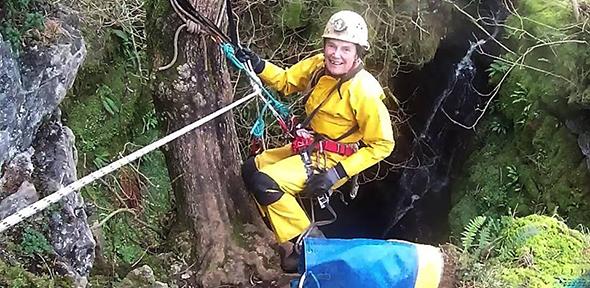
Greetings from Glossop. I have just returned here after a caving trip to the Vercors Regional Nature Park in south-east France, surviving caving, canyoning and via ferratas ('iron paths' or protected climbing ways) including in the extremely frightening lower Écouges Gorge.
I'm sorry I can't attend the Chemistry Alumni Wine Tasting in September. I am a keen potholer and caver and almost every year, the Cambridge Alumni Festival clashes with the Hidden Earth conference (run by the British Cave Research Association).
I read Natural Sciences at Girton (obtaining my BA in June 1968, and MA three years later) and am still in touch with three of my five fellow female Natural Science students at the college. I went on to do a PhD in Inorganic Chemistry working as an Aston University research assistant for Dr David Miller (who had left Cambridge). My research topic was 'the reaction kinetics of transition metal complexes with gases in solution'. It was kind Prof Émeleus who got me the job of research assistant at Aston University with Dr Miller as my supervisor. The professor took pity on me as I had burst into tears at a recruitment interview with ICI! I was Dr Miller’s first research student at Aston.
In order to enter the family pharmacy business founded by my grandfather, I then went to Manchester University and got a first in Pharmacy. During this time, a friend at Leeds University discovered caving and told me how much she enjoyed it. On her recommendation, I joined the Manchester University Speleological Society. It was the golden age of cave exploration in the Yorkshire Dales and many discoveries were made in the extensive Three Counties system, such as the Manchester Bypass and the Mancunian Way.
I subsequently made contact with the Cambridge University Caving Club and and went with them on a caving expedition to Bad Aussee in Austria 2001. They go every year to explore caves in this region on the Loser Plateau, about 80 km east of Salzburg. I attended the Club's 60th and 70th Anniversary celebrations, the latter at Kettlewell this year.
From pills to potholing. I sold the pharmacy, which had born my grandfather's name for almost a century, a few years ago. I have since written a book – A Glossop Apothecary – about it. The pharmacy had existed since 1838 and customers included the 12th Duke of Norfolk. (There is a prescription for him entered in the prescription book from 1840.) Other entries from that century illustrate the vanishing art of the apothecary. Pills were specially formulated for the aristocracy, their estate agents and entourage. Medicines included pills for gout, and draughts for constipation and alcohol-induced eczema. The book also features adverts for bronchial elixirs, and recipes for potions to make hens lay bigger eggs and for diabetic and epileptic dogs.
- A Glossop Apothecary costs £9.99 (+ £1.72 postage) and is available from Fay. E-mail finlay.mckinlay01@gmail.com or padfieldcavingclub@yahoo.co.uk
Fay Hartley.
- Image: courtesy of John Duxbury.
